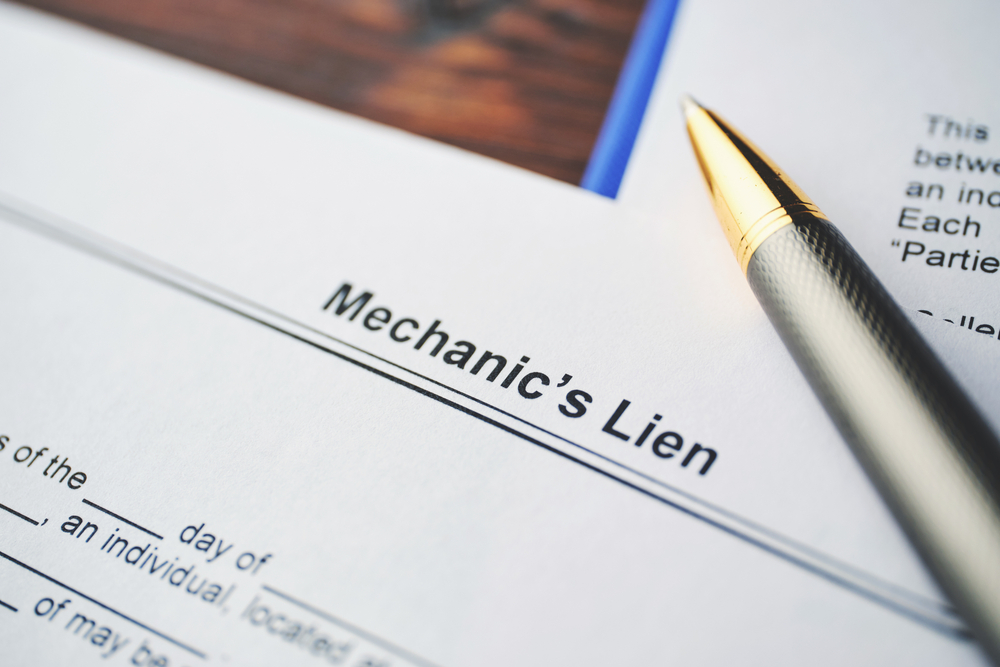

When and how you will be paid is an essential part of a subcontract. When are your pay applications due? What else needs to be turned in with your pay application? When should you expect payment? These are all issues that should be addressed in the subcontract. In this blog, we will discuss in detail what Payment Applications are and how they work.
The thought behind a standard pay application is that at the end of each month, you bill for the percentage of work you’ve completed, compared to your whole scope. The most common pay application used is the AIA (American Institute of Architects) G703 Form. The AIA G703 form is generally the second page of the AIA pay application, and the first page is the AIA G702 Form. Once you fill out the G703 form, the AIA G702 payment form is much easier to fill out, so we will start with the G703. To download examples of our G702 and our G703 forms.
On the AIA document G703, the column to the far left labeled A, is the number that corresponds with your scope list and is numbered starting at the lowest number. If you have not been given specific scope numbers, start at number 1. The next column to the right is Column B, which is a brief description of the work. For example, if you were hired to do site work and mobilization, you may have item number 1 as mobilization and item number 2 as site work.
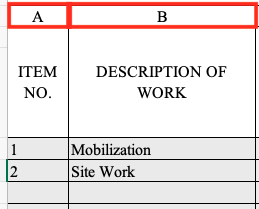
Column C is the full amount of that value of work. We are continuing with the example above, so your total contract amount is $60k, with 10k for mobilization and 50k for site work. For mobilization, Column A would have the number 1, Column B would say mobilization, and Column C would be $10k. For site work, Column A would have the number 2, Column B would say site work, and Column C would be $50k.
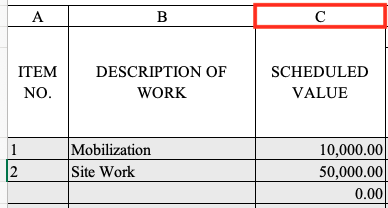
Let’s say this is pay app number 3 on our site work example. Column D would be the amount we requested in pay app 1 + the amount from pay app 2. Let’s say on pay app number 2 you billed $10k for the mobilization, and you had charged a total of $30k on pay app 1 and 2 for site work. You would list 10K for mobilization in column D, and 30k for site work.

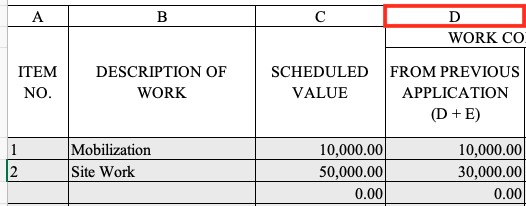
Column E is the value of the work for this pay app. For mobilization, the amount would be zero, because you have already billed 100% of the amount allowed for mobilization. If you did 10k worth of site work for this current period, 10k would go in the E column for the site work row.

Column F is for materials that are being stored onsite that have not yet been used. You can only bill the value of these materials once, and they should be included in the full scheduled value. The thought is that you will use them in the next pay period. You can bill new materials for each billing cycle. Remember it is not wise to store more than a month’s worth of materials at the project site; you will be in trouble if they are stolen.
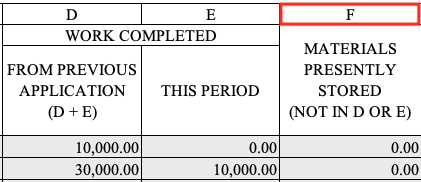
Column G is the total of completed and stored materials to date. Add Columns D+E+F to equal G. For the mobilization; Column G would be 10k. For the site work row, Column G would be 40k: 30k for work previously billed (Column D) plus 10k for work done this period (from column E).

The next column is the percent your scope is complete (G ÷ C). For the mobilization, 100% would go in this column because it is 100% complete. For the site work, it would be 80%: $40k ÷ 50k = .8 x 100 = 80%.

Column H is the dollar amount to finish that scope of work. For mobilization, column H would be zero, because that scope is 100% complete. For the site work, Column H would be 10k: the remaining amount to be billed on that scope.

Column I is the retainage on the amount from column G. If the contract requires a 10% retainage, then the mobilization line would have $1,000 in column I. For the site work, it would be 4,000: 10% of the 40k that has been billed.
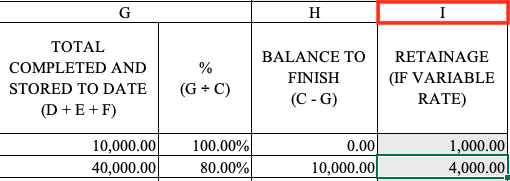
Now that you have filled out the G703, the G702 will be easier to fill out!
We are here to help you build a better business. Call us today to learn how to best protect what you’ve created.
The top part of the G702 is all the project information, what is the AIA pay application number, what are the dates covered by this pay app., etc. Number 1 is the original subcontract amount that you were hired for. Using our example, we were hired for mobilization at $10k and site work at 50K, so we would enter 60k in number 1.

Number 2 is the net change orders. This could be a positive or negative number, depending on if there were things added or reduced from your contract amount. Once you have listed all of your scopes of work on the G703, you can list all of your change orders and determine the total number for change orders. From our example, we do not have any change orders at this time, so we would enter zero in number 2.

Number 3 is number 1 + number 2, the total contract sum to date. For our example, our number 3 would be 60k.

Number 4 is the total of column G on the G703, the total amount of completed work, and stored material to date.

Number 5 is the total retainage accrued on the project to date.

Number 6 is the total earned to date, less retainage, or line 4 – line 5. In our case, it would be 50k from line 4 – 5k from line 5 =45k.

In order to complete line 7, you will need the pay app from the period before. If this were the first pay app, you would put a zero on the line. In our example, the pay application before the current one we are working on had 10k for mobilization billed and 30k for site work billed, for a total of 40k less 4k in retainage, meaning on the previous pay application, line 6 would have been 36k (40k – 4k). Therefore, line 7 in our example would be 36k.

To get the current payment due, or the line 8 amount, take line 6 (45k) less line 7 (36k) for 9k, which equals the amount of work we did for this period – (10k) less retainage of (1k).

Line 9 is the total balance left on the contract, line 3 – line 6, in our example, 60k – 45k = 15k. 10k in site work to be completed and 5k in retainage.
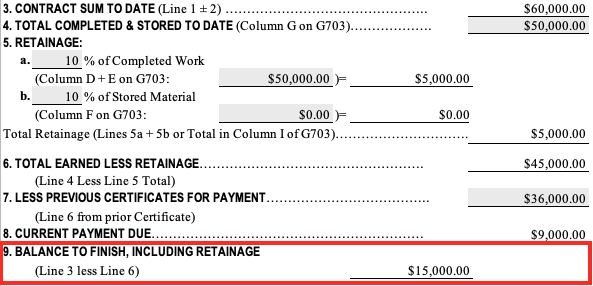
We are sure that is as clear as mud, but that is how you fill out a pay app. The more you do it, the easier it becomes!
Knowing how to protect yourself best is essential, especially when growing your business, and having a team to support you when you’re facing the potential of getting sued is a huge advantage. The Cromeens Law Firm team is here to help keep you out of the courtroom on the front end or help you win the fight inside of it. Contact us today and set yourself up for success with the support of a legal team today.
This article is intended as a general educational overview of the subject matter and is not intended to be a comprehensive survey of recent jurisprudence, nor a substitute for legal advice for a specific legal matter. If you have a legal issue, please consult an attorney.
Karalynn Cromeens is the Owner and Managing Partner of The Cromeens Law Firm, PLLC, with over 17 years of experience in construction, real estate, and business law. A published author and passionate advocate for contractors, she has dedicated her career to protecting the businesses her clients have built. Karalynn is on a mission to educate subcontractors on their legal rights, which inspired her books Quit Getting Screwed and Quit Getting Stiffed, as well as her podcast and The Subcontractor Institute.

